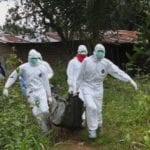 Movies and TV
Movies and TV  Movies and TV
Movies and TV  Weird Stuff
Weird Stuff 10 Times Real Laws Were Based on Bizarre Hypotheticals
 Animals
Animals 10 Inspiring Tales of Horses Being Human
 Mysteries
Mysteries Top 10 Haunting Facts About the Ghost Ship MV Alta
 History
History 10 Surprising Stories About the Texas Rangers
 Humans
Humans 10 Philosophers Who Were Driven Mad by Their Own Theories
 Miscellaneous
Miscellaneous 10 Video-Game-Worthy Weapons and Armors from History
 Weird Stuff
Weird Stuff 10 Psychics Who Accurately Predicted Wartime Events
 The Arts
The Arts 10 Pieces of Art Inspired by a Broken Heart
 Health
Health 10 Science Fiction-Sounding New Medical Treatments
 Movies and TV
Movies and TV 10 Movies That Get Elite Jobs Right, According to Experts
 Weird Stuff
Weird Stuff 10 Times Real Laws Were Based on Bizarre Hypotheticals
 Animals
Animals 10 Inspiring Tales of Horses Being Human
Who's Behind Listverse?

Jamie Frater
Head Editor
Jamie founded Listverse due to an insatiable desire to share fascinating, obscure, and bizarre facts. He has been a guest speaker on numerous national radio and television stations and is a five time published author.
More About Us Mysteries
Mysteries Top 10 Haunting Facts About the Ghost Ship MV Alta
 History
History 10 Surprising Stories About the Texas Rangers
 Humans
Humans 10 Philosophers Who Were Driven Mad by Their Own Theories
 Miscellaneous
Miscellaneous 10 Video-Game-Worthy Weapons and Armors from History
 Weird Stuff
Weird Stuff 10 Psychics Who Accurately Predicted Wartime Events
 The Arts
The Arts 10 Pieces of Art Inspired by a Broken Heart
 Health
Health 10 Science Fiction-Sounding New Medical Treatments
10 Deadliest Places to Scuba Dive
Almost three-quarters of our blue planet is covered in water, and—for an equally accurate and verifiable statistic—absolutely every inch of it is terrifying and evil. Much of Earth’s water is unexplored, deep, dark, frigid, and home to nightmare-inducing creatures that float through the seas like slimy ghosts. Even the shallows we’re familiar with can come with treacherous rapids, hidden caves, boiling vents, noxious gas plumes, and more. Somehow, despite all of that, diving remains a super popular pastime.
Every year, millions of divers suit up and sink down into pretty much any body of water that they can. In the process, many remerge with transcendent memories and breathtaking photographs, but also: many die. About 100-200 of them each year, on average.
This list contains both spots known to have taken divers and those with untapped lethal potential, but all of them are some of the deadliest places to scuba dive.
Related: 10 Rare Finds Proving The Ocean Is A Weird Place
10 Chuuk Lagoon
Chuuk Lagoon—formerly Truk Atoll—is a set of islands and coral reefs within the Federated States of Micronesia. It is actually an ideal place to scuba dive in so many ways—it boasts clear blue water, an impressive assortment of marine life, and an entire fleet of sunken ships at which to marvel. However, if there’s one small, itty-bitty catch to the lagoon, it would have to be thousands of bombs, grenades, mines, depth charges, torpedos, and other explosives scattered throughout its area.
During World War II, Chuuk Lagoon played host to the Empire of Japan’s main naval base. When the U.S. Navy attacked and destroyed the base in 1944, it became, in The New York Times’s words, “the biggest graveyard of ships in the world.” Perhaps the most dangerous aspect of the Chuuk graveyard is just how much of its contents are still a mystery; several major ships, alongside their explosive cargo, are still missing. The same is true for aircraft and even tanks as well.
9 Citarum River
The Citarum River, one of the largest in Indonesia, is one of the entries on this list that probably doesn’t get many scuba divers as is. Still, if any foolish daredevils were to try, they would quickly learn why people consider the Citarum the most polluted river in the world.
More than 2,000 factories dump waste into the river, an estimated 20,000 tons of it daily. As a result, many stretches of the river are completely unrecognizable as water. Instead, they’re covered in plastics, styrofoam, and other non-biodegradable garbage. But even the clearer waters are deadly; mercury, PCBs, lead, arsenic, and other toxic substances permeate almost every gallon of the tragic Citarum River.
8 Bolton Strid
The River Wharfe flows for over 60 miles through the area around Yorkshire, England, and almost every bit of its length is quaint, charming, idyllic, and serene. That is only true at its surface and banks, though, because the deep parts of the river can be deadly. So deadly that the river has earned two dubious distinctions: “one of the deadliest bodies of water in the world” and, for those who fall in, a “100 percent mortality rate.”
The Strid’s lethality comes from the fact that, in some areas, an otherwise 30-foot-wide river is condensed into a mere six-foot width, leading to an instant and exponential increase in current, pressure, and number of whirlpools. To top it off, several stretches in the faster parts of the Strid—though still only around six feet wide—reach tens of meters in depth. The waters at the bottom are quick, cold, fast, and chaotic and have led to innumerable deaths.
7 Lake Karachay
Depending on your reasons for reading a list of most dangerous diving sites, it may come as either great news or terrible news that the #7 entry on this list was recently filled in with concrete. It is no longer dive-able. But for about 65 years, Russia’s Lake Karachay may very well have been the single most dangerous body of water in the world. It was so hazardous that even filling it in completely didn’t remove its lethality.
From 1951 to 1957, the Soviet Union used Lake Karachay as a dumping ground for nuclear waste. Then the Kyshtym disaster further contaminated the area, raising its baseline radiation levels to near-Chernobyl levels. At its height in the 1990s, the radiation in Lake Karachay was enough to kill a human within an hour. The area is radioactive and completely off-limits even now, fully filled in.
6 The Eagle’s Nest
The Eagle’s Nest in remote Florida is a system of underwater caves that makes many “deadliest” lists, and with good reason: its deceptively simple surface level quickly descends into one of the deepest, darkest, deadliest scuba locations in the world.
The sinkhole looks from its banks like a typical, small pond. However, anyone diving into the pond quickly learns the truth: the water descends straight down, more than 300 feet into blackness. At that level, a high risk of deadly depth intoxication threatens divers even without factoring in the twisting, narrow passageways in which the divers must then proceed. At least ten professional divers have died exploring The Eagle’s Nest.
5 Battery Acid Bath
Technically, this entry is more thousands of places than one, but they all share one deadly property: acid water. For some of these caustic bodies, their water is more acidic and more concentrated than even battery acid.
Bodies of water can become overly acidic in several ways, but one standard method is through drainage from a nearby mine. Coal mines tend to be the worst offenders, inadvertently (and sometimes purposefully) dumping acidic metals and sulfides into rivers and lakes. Oddly enough, the result is occasionally beautiful, turning rivers deep red, orange, yellow, or green. Diving in these waters, though, is a death sentence; the water in one mine in Iron Mountain in California was found to be the most acidic ever discovered. Its pH: -0.7!
It’s likely you just learned that the pH scale can go below zero, and that should tell you how dangerous these waters can be.
4 Lake Nyos
When a body of water kills so many people, so quickly, that it becomes the namesake for a famous disaster, you can bet that steering clear of its water is a good idea. In 1986, Lake Nyos in northwestern Cameroon did just that when the “Lake Nyos Disaster” killed more than 1,700 people.
Essentially, Nyos’s waters have the misfortune of resting above pockets of underground magma, which constantly leak CO2 upwards. The result is that the lake is prone to a rare phenomenon known as a limnic eruption, which causes huge amounts of CO2 absorbed into the water to suddenly erupt from the water as a cloud of toxic gas. This cloud, some 100,000-300,000 tons of CO2, shot out of the Lake’s waters, spread throughout the immediate area, including several local villages and 1,746 people.
Careful diving in.
3 The Boiling Lake
The lake’s name says it all on this one. Hidden within the lush, tropical mountains of the Caribbean island of Dominica lies Boiling Lake, and that title is hardly metaphorical. Essentially, it’s a flooded fumarole.
Though it’s hard to find any recent records of the water’s temperatures, as presumably, scientists are more rational these days, a record from two scientists in 1875 put the temperature at the water’s edge at 180 to 197 degrees Fahrenheit. However, they could not record temperatures farther in the lake, as the water was literally boiling, damaging both their instruments and their bravery.
2 Iceberg B-15
Moving from one temperature extreme to another, we have Iceberg B-15, which you may have heard of. At over 3,200 square miles, it was the most enormous iceberg ever recorded until enough chunks broke off to give another the crown. B-15 contained caves and water, and therefore, of course, people cave dove in it.
Three filmmakers for National Geographic decided to dive into the icy, black waters inside the iceberg’s caves, and their account of the trip is harrowing. Some tidbits, as terrifying as they are tantalizing, from diver Jill Heinerth are as follows: “One minute is dangerous. I mean you very, very quickly lose the ability to manipulate your hands or operate or even think straight,” “There were also strange cracks and pops and groans from the ice. It was moving, it was shifting, it was changing,” and “The cave tried to keep us today.”
1 The Blue Hole
If you’re familiar with scuba diving, or even just the bevy of “Most Extreme” specials that Nat Geo airs on a loop, then you’re likely not surprised that the Red Sea’s blue hole makes the top spot on this list. If you are surprised, it’s likely that you don’t know the site by either of its nicknames: “World’s Most Dangerous Dive Site” and “Divers’ Cemetery.”
There are blue holes, substantial marine sinkholes where otherwise clear waters quickly fall into crushing depths and darkness, all over the world. Many have gained notorious reputations from divers, but none more so than the blue hole off the coast of Dahab, Egypt. Its actual body count is unknown but is estimated to be around 200.
Though its challenges are straightforward, they are nonetheless tricky enough to be deadly. According to diving instructor Alex Heyes, divers attempting to swim under the hole’s rocky arches are often unaware that “this challenge is to scuba divers what Kilimanjaro is to hikers.” And as such, the fatalities continue.








